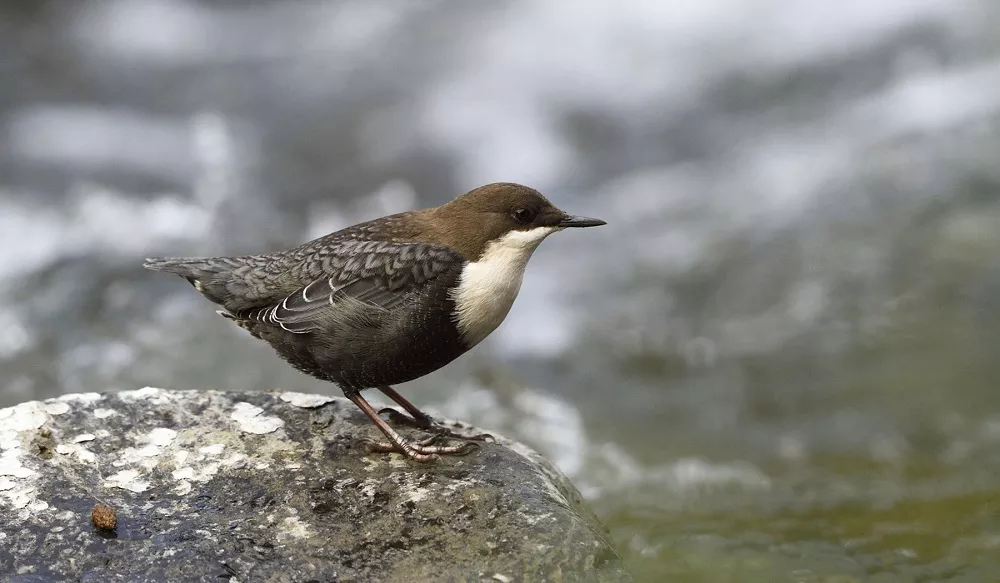The white throated dipper (Cinclus cinclus), also known as the European dipper or just dipper, is an aquatic passerine bird found in Europe, Middle East, Central Asia and the Indian Subcontinent. The species is divided into several subspecies, based primarily on color differences, particularly of the pectoral band. The white-throated dipper is Norway’s national bird.
What does a White-throated dipper look like
The white throated dipper is 17-20cm in length, 25-30cm in wingspan, 55-75g in weight, and has a lifespan of 8 years.
Male: White type: forehead, top of head, nape of neck, upper back dark brown with pale tips; lower back to tail overlying slate gray with looming dark markings. The wings are brown, and the outer feathers have slate gray feather edges. Tail feathers brownish gray. Eye rims are off-white; eyes and ear feathers are brown. Chin, throat, and breast white; abdomen, flanks thick brown with dark brown; undertail coverts grayish brown; axillary feathers, underwing coverts brown, feather tips gray
Brown type: the upper body is similar to the white type, but the color from the forehead to the back of the neck is lighter. The chin, throat, and chest are dark brown; the abdomen, sides, and undertail coverts are dark brown, and the latter is stained with gray, and the feather margins are light. Female bird: similar to the male bird in shape.
Juvenile (white type): dark slate gray from forehead to tail, with dark brown margins forming scaly markings. Wing feathers dark brown, with gray outer margins and off-white tips. Chin to chest stained white, with brown fine spots, chest is conspicuous; abdomen and flanks grayish brown, center of abdomen stained white with earthy brown.
Young bird (brown type): the upper body plumage color is similar to that of the white type adult bird. Chin, throat, and chest of lower body brown, with gray-white edge; rest of lower body dark brown.
Iris dark brown; beak black; tarsus and toes dark brown in adult birds, light yellowish brown in juvenile birds.
The white-throated dipper has plump body feathers, a slender and pointed beak, short wings and tail, a thrush-like beak and legs, and impermeable feathers. There is a movable cover on the nostril and a third eyelid on the eye, all of which are adapted to a semi-aquatic life.
White-throated dipper habitats
It inhabits forests above 1500 meters and clear and swift mountain streams in open areas. There is seasonal vertical migration in some areas.
White-throated dipper living habits
It inhabits and lives on boulders or fallen logs on both sides of mountain rivers. It just flies up and down along the water surface of the river, and does not take a flight from the air when it encounters a bend in the river. It can swim on the surface and dive underwater. The white throated dipper usually moves in pairs and flies close to the surface of the water. In winter, it gathers in small flocks, usually with 2-7 only, to move and look for food in the ice caves and unfreezing waters of the river.
It looks for food among the gravels at the bottom of the water or among the gravels on the water surface and on the river beach. It mainly feeds on aquatic insects and other larvae, and also feeds on aquatic small invertebrates. In addition, it also eats seeds and leaves of wild plants such as Polygonaceae, Gramineae, etc., small fish, crustaceans, spiders, snails, etc.
Mode of reproduction
It breeds from April to July every year, with one litter a year. The nest is built in the shape of a dome under rocks or tree roots near the water. Nest materials are grass roots, grass stems, wool, paper, moss, birch bark, leaves of broad-leaved trees and some ferns; 4-5 eggs per clutch, pure white, hatched by the female bird, the incubation period is 16-18 days; The male and female parents brood together, and the brooding period is 23 days.


 Facebook
Facebook  Instagram
Instagram  Youtube
Youtube 